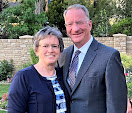Capitol Reef Field Station: Utah Valley University's Connection to Nature
Darrel L. Hammon
Capitol Reef National Park—Joanne and I experienced a marvelous day on Saturday, November 8, 2014, spending time at Utah Valley University’s (UVU) Capitol Reef Field Station, located strategically within Capitol Reef National Park, an
incredible landscape of anciently formed rocks and unique landscapes.
Just
below the Field Station, runs Pleasant Creek, that, according to the record, “breaks
free of its narrow canyon walls upstream from the Capitol Reef Field Station
and before it cuts through the Waterpocket Fold downstream, it nourishes a
small oasis of tall grasses, wildflowers, shady cottonwoods, and aromatic
sagebrush. Pleasant Creek has been a sanctuary for a very long time” (http://www.uvu.edu/crfs/location/history.html).
Utah Valley University, the Park Service, a host of
professors, donors, and congressmen joined forces and created the Capitol Reef
Field Station, a collaborative partnership between the Capitol Reef Park
Service and UVU. The Capitol Reef Field Station’s mission, “in partnership with
Capitol Reef National Park, promotes and supports engaged learning, research,
scholarly, and creative activities, and environmental ethics through the
exploration of the Colorado Plateau” (See (http://www.uvu.edu/crfs/about/mission.html).
Along the way, I took pictures of cool rock formations, huge
rocks with names of some of the surveyors, a broken down fence line that I am
sure was constructed to keep animals in or animal out, rock formations along
the trail and ahead of us at the mouth of the canyon, and other oddly-shaped
rocks that had fallen from some of the rock cliffs.
Our jaunt up the canyon revealed rock formations, etchings of
past passerbys, surveyors, and families who came to settle the valley. Ephraim
Hanks and his family were the early settlers, building their little ranch on
the banks of Pleasant Creek and converted some of the water into ditches so
they could irrigate the 200 fruit trees—pears, peach, apples—they had planted.
History states that when the trees were in bloom, it was a magnificent site.
Thus, ranch donned the name of “Floral Ranch.” Over the years, the Floral Ranch
passed from one descendant to another until one of them quit claimed it to the
national park.
On our walk, we entered a cove of sorts, and were instantly
surround by high, colorful walls, replete with a range of oranges and sandstone
colors. Our voices echoed! We sat one some of the small ledges the winds had
made. High in one corner was an opening, but I could still see even higher slabs
of solid rock with the same color strata. I suspect the sun didn’t shine in
this cove very often, even during the throes summer.
I took hundreds of pictures, none of the really depicting
the actual landscape, created hundreds of thousands of years ago. For me, I
was again convinced that this type of beauty and majesty just do not happen ad
hoc. Rather, the greater Creator, even God Himself, was the architect of this
great plan for our world. How else can one truly explain the incredibleness of
it all? In the LDS Hymnbook, #86, the
lyrics explain the greatness of God’s creations:
When thru the woods and forest glades I wander
And hear the birds sing sweetly in the trees
When I look down, from lofty mountain grandeur
And hear the brook and feel the gentle breeze….
And hear the birds sing sweetly in the trees
When I look down, from lofty mountain grandeur
And hear the brook and feel the gentle breeze….
How Great Thou art….
How Great Thou art.





















No comments:
Post a Comment